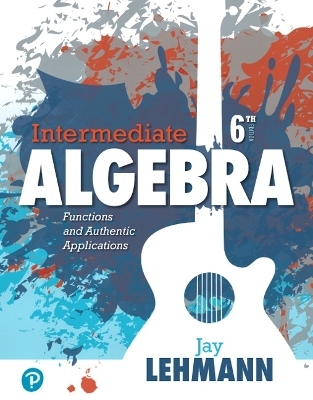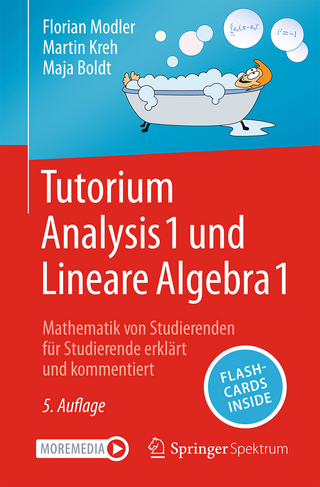
Intermediate Algebra
Pearson (Verlag)
978-0-13-475698-1 (ISBN)
- Titel erscheint in neuer Auflage
- Artikel merken
Modeling authentic data through curve-fitting gives students new meaning to the math
Seeking the answer to students’ perennial question “But what is this good for?” the Lehmann Algebra Series uses authentic, real-life data sets to find models and derive equations that fit the scenario. The curve-fitting approach teaches the mathematical concepts within the context of data, getting students engaged from the start and building conceptual understanding.
Updates in this revision keep the data sets authentic and current, and provide even more resources for students to practice, review, and explore the concepts.
Also available with MyLab Math
By combining trusted author content with digital tools and a flexible platform, MyLab personalizes the learning experience and improves results for each student.
Note: You are purchasing a standalone product; MyLab Math does not come packaged with this content. Students, if interested in purchasing this title with MyLab Math, ask your instructor to confirm the correct package ISBN and Course ID. Instructors, contact your Pearson representative for more information.
If you would like to purchase both the physical text and MyLab Math, search for:
0134776097 / 9780134776095 Intermediate Algebra: Functions and Authentic Applications Plus MyMathLab -- Access Card Package, 6/e
Package consists of:
0134756983 / 9780134756981 Intermediate Algebra: Functions and Authentic Applications, 6/e
0134807197 / 9780134807195 MyMathLab with Pearson eText -- Standalone Access Card -- for Intermediate Algebra: Functions and Authentic Applications, 6/e
About our author Jay Lehmann has taught for the past 25 years at College of San Mateo, where he received the “shiny apple award” for excellence in teaching. He has presented at over 80 conferences including AMATYC and ICTCM over the past 16 years. Jay is currently the newsletter editor for California Mathematics Council, Community Colleges (CMC3). Still young at heart, he plays in a rock band appropriately named the Procrastinistas. Jay has authored several algebra textbooks published by Pearson and has also recently completed a Prestatistics textbook. In the words of the author: “Before writing my algebra series, it was painfully apparent that my students couldn't relate to the applications in the course. I was plagued with the question, "What is this good for?" To try to bridge that gap, I wrote some labs, which facilitated my students in collecting data, finding models via curve fitting, and using the models to make estimates and predictions. My students really loved working with the current, compelling, and authentic data and experiencing how mathematics truly is useful. “My students' response was so strong that I decided to write an algebra series. Little did I know that to realize this goal, I would need to embark on a 15-year challenging journey, but the rewards of hearing such excitement from students and faculty across the country have made it all worthwhile! I'm proud to have played even a small role in raising people’s respect and enthusiasm for mathematics. “I have tried to honor my inspiration: by working with authentic data, students can experience the power of mathematics. A random-sample study at my college suggests that I am achieving this goal. The study concludes that students who used my series were more likely to feel that mathematics would be useful in their lives (P-value 0.0061) as well as their careers (P-value 0.024). “The series is excellent preparation for subsequent courses; in particular, because of the curve fitting and emphasis on interpreting the contextual meaning of parameters, it is an ideal primer for statistics. In addition to curve fitting, my approach includes other types of meaningful modeling, directed-discovery explorations, conceptual questions, and of course, a large bank of skill problems. The curve-fitting applications serve as a portal for students to see the usefulness of mathematics so that they become fully engaged in the class. Once involved, they are more receptive to all aspects of the course.”
Linear Equations and Linear Functions
1.1 Using Qualitative Graphs to Describe Situations
1.2 Graphing Linear Equations
1.3 Slope of a Line
1.4 Meaning of Slope for Equations, Graphs, and Tables
1.5 Finding Linear Equations
1.6 Functions
Modeling With Linear Functions
2.1 Using Lines to Model Data
2.2 Finding Equations of Linear Models
2.3 Function Notation and Making Predictions
2.4 Slope Is a Rate of Change
Taking It to the Lab: Climate Change Lab • Used-Car Lab • Golf Ball Lab • Walking Student Lab • Linear Lab: Topic of Your Choice
Systems of Linear Equations and Systems of Linear Inequalities
3.1 Using Graphs and Tables to Solve Systems
3.2 Using Substitution and Elimination to Solve Systems
3.3 Using Systems to Model Data
3.4 Value, Interest, and Mixture Problems
3.5 Using Linear Inequalities in One Variable to Make Predictions
3.6 Linear Inequalities in Two Variables; Systems of Linear Inequalities
Taking It to the Lab: Climate Change Lab (continued from Chapter 2) • Sports Lab • Truck Lab
Exponential Functions
4.1 Properties of Exponents
4.2 Rational Exponents
4.3 Graphing Exponential Functions
4.4 Finding Equations of Exponential Functions
4.5 Using Exponential Functions to Model Data
Taking It to the Lab: Stringed Instrument Lab • Cooling Water Lab • Exponential Lab: Topic of Your Choice
Logarithmic Functions
5.1 Composite Functions
5.2 Inverse Functions
5.3 Logarithmic Functions
5.4 Properties of Logarithms
5.5 Using the Power Property with Exponential Models to Make Predictions
5.6 More Properties of Logarithms
5.7 Natural Logarithm
Taking It to the Lab: China and India Populations Lab • Folding Paper Lab • Exponential/Logarithmic Lab: Topic of Your Choice
Polynomial Functions
6.1 Adding and Subtracting Polynomial Expressions and Functions
6.2 Multiplying Polynomial Expressions and Functions
6.3 Dividing Polynomials: Long Division and Synthetic Division
6.4 Factoring Trinomials of the Form x2 + bx + c; Factoring Out the GCF
6.5 Factoring Polynomials
6.6 Factoring Special Binomials; A Factoring Strategy
6.7 Using Factoring to Solve Polynomial Equations
Taking It to the Lab: Climate Change Lab (continued from Chapter 3) • Projectile Lab
Quadratic Functions
7.1 Graphing Quadratic Functions in Vertex Form
7.2 Graphing Quadratic Functions in Standard Form
7.3 Using the Square Root Property to Solve Quadratic Equations
7.4 Solving Quadratic Equations by Completing the Square
7.5 Using the Quadratic Formula to Solve Quadratic Equations
7.6 Solving Systems of Linear Equations in Three Variables; Finding Quadratic Functions
7.7 Finding Quadratic Models
7.8 Modeling with Quadratic Functions
Taking It to the Lab: Climate Change Lab (continued from Chapter 6) • Projectile Lab (continued from Chapter 6) • Projectile Lab (Using a CBR or CBL) • Water Flow Lab • Quadratic Lab: Topic of Your Choice
Rational Functions
8.1 Finding the Domains of Rational Functions and Simplifying Rational Expressions
8.2 Multiplying and Dividing Rational Expressions; Converting Units
8.3 Adding and Subtracting Rational Expressions
8.4 Simplifying Complex Rational Expressions
8.5 Solving Rational Equations
8.6 Modeling with Rational Functions
8.7 Variation
Taking It to the Lab: Climate Change Lab (continued from Chapter 7) • Illumination Lab • Boyle’s Law Lab
Radical Functions
9.1 Simplifying Radical Expressions
9.2 Adding, Subtracting, and Multiplying Radical Expressions
9.3 Rationalizing Denominators and Simplifying Quotients of Radical Expressions
9.4 Graphing and Combining Square Root Functions
9.5 Solving Radical Equations
9.6 Modeling with Square Root Functions
Taking It to the Lab: Pendulum Lab
Sequences and Series
10.1 Arithmetic Sequences
10.2 Geometric Sequences
10.3 Arithmetic Series
10.4 Geometric Series
Taking It to the Lab: Bouncing Ball Lab • Stacked Cups Lab
Additional Topics
11.1 Absolute Value: Equations and Inequalities
11.2 Performing Operations with Complex Numbers
11.3 Pythagorean Theorem, Distance Formula, and Circles
11.4 Ellipses and Hyperbolas
11.5 Solving Nonlinear Systems of Equations
APPENDICES
A. Reviewing the Prerequisite Material
B. Using a TI-83 or TI- 84 Graphing Calculator
C. Using StatCrunch
| Erscheinungsdatum | 26.03.2018 |
|---|---|
| Sprache | englisch |
| Maße | 100 x 100 mm |
| Gewicht | 100 g |
| Themenwelt | Mathematik / Informatik ► Mathematik ► Algebra |
| ISBN-10 | 0-13-475698-3 / 0134756983 |
| ISBN-13 | 978-0-13-475698-1 / 9780134756981 |
| Zustand | Neuware |
| Informationen gemäß Produktsicherheitsverordnung (GPSR) | |
| Haben Sie eine Frage zum Produkt? |
aus dem Bereich



